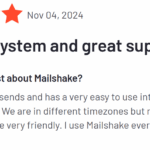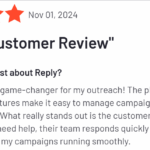Saleshandy vs Emelia: Key Differences Explained

Saleshandy vs Emelia: Key Differences Explained
In the ever-evolving landscape of sales and communication tools, Saleshandy vs Emelia presents a compelling comparison for businesses seeking to enhance their productivity and efficiency. Both platforms are designed to streamline sales processes and improve communication, yet they cater to different needs and offer unique features that set them apart. Understanding these differences is crucial for organizations looking to invest in the right tool that aligns with their specific requirements. This article delves into the core functionalities, user interface and experience, pricing comparison, customer support, and ultimately summarizes the key differences between Saleshandy and Emelia.
Core Functionalities
Saleshandy Features
At its core, Saleshandy is primarily focused on email tracking, document tracking, and email scheduling. This platform provides users with valuable insights into how recipients interact with their emails, such as whether they opened them or clicked on links. Such features are particularly beneficial for sales teams aiming to optimize their outreach strategies and follow up effectively. The email tracking functionality allows users to receive real-time notifications when their emails are opened, enabling timely follow-ups that can significantly increase conversion rates. Additionally, Saleshandy offers document management capabilities, allowing users to create, share, and track documents. This is essential for sales presentations and proposals, as it ensures that sales teams can monitor engagement with their materials and adjust their strategies accordingly. Furthermore, Saleshandy includes features like email templates, mail merge, and analytics, which empower users to create personalized outreach campaigns and analyze their performance over time.
Emelia Features
In contrast, Emelia is designed as a more comprehensive sales engagement platform that goes beyond the capabilities of email tracking. Emelia integrates various communication channels, including email, phone calls, and social media, into a single platform. This multi-channel approach allows sales teams to engage with prospects through their preferred communication methods, enhancing the overall customer experience. Emelia emphasizes automation and personalization, enabling users to create tailored outreach campaigns that can be automated based on specific triggers or recipient behaviors. For instance, users can set up automated follow-up emails that are triggered by specific actions taken by the recipient, such as opening an email or clicking on a link. Additionally, Emelia offers advanced analytics and reporting features that provide insights into the effectiveness of different communication strategies, allowing sales teams to refine their approaches based on data-driven decisions. Overall, Emelia's robust feature set makes it an ideal choice for organizations looking for a holistic sales engagement solution that encompasses various communication channels and emphasizes automation.
Related Topic: Saleshandy vs Instantly vs Emailchaser: Which is Best?
Saleshandy vs Instantly vs Emailchaser: Which is Best?User Interface and Experience
Saleshandy User Experience
When it comes to user interface and experience, Saleshandy vs Emelia presents distinct differences that can influence user adoption and satisfaction. Saleshandy offers a straightforward and user-friendly interface that focuses primarily on email-related tasks. The design is clean and intuitive, making it easy for users to navigate and utilize its features without extensive training. The dashboard provides a clear overview of email tracking metrics, document engagement, and scheduled emails, allowing users to quickly access the information they need. This simplicity is particularly advantageous for small businesses and individual users who may not have the time or resources to invest in extensive training. Moreover, Saleshandy’s integration with popular email clients like Gmail and Outlook further enhances its usability, as users can seamlessly incorporate the tool into their existing workflows.
Emelia User Experience
On the other hand, Emelia's interface is designed to accommodate a broader range of functionalities, which may require a steeper learning curve for new users. While the platform offers a wealth of features, the complexity of its interface can be overwhelming for those who are accustomed to simpler tools. However, this complexity allows for more advanced features and integrations that can be beneficial for larger sales teams or organizations with diverse communication needs. Emelia’s dashboard provides a comprehensive view of all communication channels, allowing users to manage their outreach efforts from a single location. The platform also offers customizable workflows and automation settings, which can enhance productivity but may require additional time to set up and optimize. Overall, while Emelia may present a more complex user experience, its advanced capabilities can provide significant value for organizations willing to invest the time in learning the platform.
Pricing Comparison
Saleshandy Pricing
Pricing is another critical differentiator between Saleshandy and Emelia. Saleshandy typically offers a more affordable pricing structure, making it accessible for small businesses and individual users who primarily need email tracking and document management. The platform often provides a free trial, allowing users to explore its features before committing to a paid plan. Saleshandy’s pricing tiers are designed to cater to different user needs, with options that include basic features for individual users and more advanced functionalities for teams. This flexibility in pricing makes Saleshandy an attractive option for startups and small enterprises looking to enhance their sales processes without incurring significant costs.
Related Topic: Saleshandy vs Instantly vs Smartlead: Key Differences Explained
Saleshandy vs Instantly vs Smartlead: Key Differences ExplainedEmelia Pricing
In contrast, Emelia, while potentially more expensive, provides a wider array of features that justify the cost for larger organizations or those seeking a more integrated sales solution. Emelia’s pricing structure is typically tiered based on the number of users and the level of features required. While this may result in higher upfront costs, the comprehensive nature of the platform can lead to increased efficiency and productivity, ultimately providing a strong return on investment for larger teams. Additionally, Emelia may offer customized pricing plans for enterprises, which can include dedicated support and onboarding assistance, further enhancing its value proposition for organizations with complex sales processes. In summary, while Saleshandy offers a budget-friendly option for smaller users, Emelia’s pricing reflects its extensive capabilities and is better suited for larger organizations with diverse communication needs.
Customer Support and Resources
Saleshandy Support
When it comes to customer support and resources, both platforms offer assistance, but their approaches may differ significantly. Saleshandy provides support primarily through online resources, including tutorials, FAQs, and a knowledge base. This self-service approach allows users to find answers to their questions quickly and efficiently. However, for users who require more personalized assistance, Saleshandy also offers email support, which can be beneficial for resolving specific issues. The availability of online resources is particularly advantageous for users who prefer to learn at their own pace and may not require immediate assistance. Overall, Saleshandy’s support structure is well-suited for users who are comfortable navigating online resources and prefer a more independent approach to learning the platform.
Emelia Support
In contrast, Emelia may offer more personalized support options, such as dedicated account managers or onboarding assistance, which can be advantageous for teams looking for more hands-on guidance. This level of support is particularly beneficial for larger organizations that may require tailored training and assistance to fully leverage the platform’s capabilities. Emelia’s customer support team is typically available through multiple channels, including live chat, email, and phone support, ensuring that users can receive timely assistance when needed. Additionally, Emelia often provides comprehensive onboarding programs that help new users acclimate to the platform and maximize its features from the outset. This commitment to customer support can significantly enhance the user experience and ensure that organizations can effectively implement the platform into their sales processes.
Related Topic: Saleshandy vs Instantly vs Mystrika: Key Differences Explained
Saleshandy vs Instantly vs Mystrika: Key Differences ExplainedSummary of Key Differences
In summary, the key differences between Saleshandy vs Emelia revolve around their core functionalities, user experience, pricing, and support structures. Saleshandy excels in email and document tracking, making it ideal for users focused on email outreach and document management. Its user-friendly interface and affordable pricing structure make it an attractive option for small businesses and individual users. On the other hand, Emelia offers a more comprehensive sales engagement solution that integrates multiple communication channels and emphasizes automation and personalization. While its interface may present a steeper learning curve, the advanced features and personalized support options make it a valuable choice for larger organizations with diverse communication needs. Ultimately, the choice between the two platforms depends on the specific needs and goals of the user or organization, as each tool offers distinct advantages that cater to different sales strategies and workflows.
If you want to discover other articles similar to Saleshandy vs Emelia: Key Differences Explained, you can visit the Tools and Reviews category.

Related Posts: